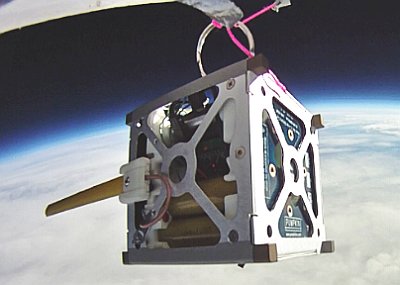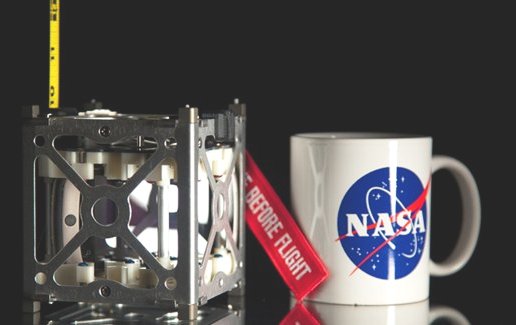PhoneSat v2.4
NASA Ames Research Center

PhoneSat v2 is a technology demonstration mission intended to increase the functional capabilities of PhoneSat v1 and demonstrate complete satellite functionally in a low cost package. The satellite is built around the Nexus S smartphone which will be running the Android operating system and will be enclosed in a standard 1U cubesat structure. The main function of the phone is to act as the Onboard Computer, but the mission will also utilize the phone’s SD card for data storage, 5MP camera for Earth Observation, 3-axis gyroscope and 3-axis magnetometer for Attitude Determination, and 3-axis reaction wheel control system and 3-axis magnetorquer control system for Attitude Control.
NASA-Catalog: ?
Downlink
437.425 MHz, FM, 1k2 AFSK AX.25, 30 sec interval
Call
Status
The launch of a Minotaur I rocket for the U.S. Air Force ORS-3 mission is scheduled to occur on November 20, 2013 from Wallops Flight Facility (WFF), Virginia, with a planned launch window from 00:30 – 02:00 UTC. The launch, from ignition to delivery of the satellites in orbit, will take a little less than twelve-and-a-half minutes, with a targeted 500 km circular orbit at an inclination of 40.5 degrees.
Mission
Telemetry
Links und weitere Informationen
PhoneSat v1
NASA Ames Research Center
PhoneSat is a nanosatellite, categorizing the mass as between one and ten kilograms. Additionally, PhoneSat is a 1U CubeSat, having a volume of around one liter. The PhoneSat Project strives to decrease the cost of satellites while not sacrificing performance. In an effort to achieve this goal, the project is based around Commercial Off-The-Shelf (COTS) electronics to provide functionality for as many parts as possible while still creating a reliable satellite. Two copies of PhoneSat 1.0 (a and b) are being launched mid April 2013 along with an early prototype of PhoneSat 2.0 referred to as PhoneSat 2.0.beta.
NASA-Catalog: 39146 (GRAHAM), 39145 (BELL) and 39144 (ALEXANDER)
Downlink
437.425 MHz, FM, 1k2 AFSK AX.25
Call
GRAHAM (ID A) – KJ6KRW-2
BELL (ID B) – KJ6KRW-1
ALEXANDER – KJ6KRW
Status
deorbited on 2013/04/27
The two PhoneSat 1.0 satellites, Graham and Bell, transmit with a periodicity of respectively 28 seconds and 30 seconds. The PhoneSat 2.0 beta satellite, Alexander, transmit with a periodicity of 25 seconds.
They are going to a very low orbit so they will only stay on orbit for about 10 days. The satellites are beaconing data down using the radio amateur band frequency at 437.425MHz. The mission consists of taking some pictures of the Earth and sending them to ground in the form of small packets of data. Because it is a such a low orbit, we need to have as many radio ground stations around the world as possible in order to accomplish the mission.
The main mission objective is to demonstrate each of the core subsystems: Attitude Determination, Attitude Control, Two-way communications and solar cell power generation.
- 1U standard cubesat structure provided by Pumpkin, inc.
- Size: 10x10x10 cm
- Weight: 1.3kg
- Antenna: quarter wave monopole tape measure antenna placed at the middle of one of the edges of the cube
Telemetry
PhoneSat 1.0
Three different types of packets ASCII85 encoded. We are encoding bits instead of ASCII characters. Therefore, if you want to decode the packet, normal online ASCII85 decoders will not work. Use PhoneSat’s Decoder to decode your packets.
Health Data Packet
After being decoded, the packets will contain the following data:
ID: 1byte, identifier of which satellite you have received from. Restarts: number of restarts of the PhoneSat App. Reboots: number of reboots of the phone. Counter: number of packets sent since the beginning of the mission. Phase1: number of packets sent during phase 1 (only health data). Phase2: number of packets sent during phase 2 (health data and picture packets). Time: unix time in seconds. Voltage: battery Voltage in Volts. Temp1: exterior temperature in Kelvin. Temp2: interior temperature in Kelvin. Accel: accelerometer value for X, Y, Z axes from the phone sensor in m/sec2. Compass: magnetic field value for X, Y, Z axes from the phone sensor in nanoTesla. Text: “hello from the avcs”.
Safe Mode Packets
V: Last ten values of the Voltage prior to last reboot in Volts. OutT: Last ten values of the Exterior Temperature prior to last reboot in Kelvin. InT: Last ten values of the Interior Temperature prior to last reboot in Kelvin.
Picture Packets
These pictures can be converted into png pictures using Google’s webp converter. You will receive small parts of one big picture and once we have all the pieces, we will put it together and post it in our website!
PhoneSat-2
Sensors from the phone
Time: unix time time in milli seconds. Reboot: number of reboots of the phone. Counter: number of packets sent since the beginning of the mission. Packet type: for this packet will be sensors from the phone (1). Phase: phase in which the satellite is (we have 3 phases). Compass: magnetic field value for X, Y, Z axes from the phone sensor in nanoTesla. Gyro: spin rate for X, Y, Z axes from the phone sensor in deg/sec. Accel: accelerometer value of X, Y, Z axes from the phone sensor in m/sec2.
Current and voltage values
Time: unix time in milli seconds. Reboot: number of reboots of the phone. Counter: number of packets sent since the beginning of the mission. Packet type: for this packet will be current and voltage values (2). Phase: phase in which the satellite is (we have 3 phases). Voltage: battery voltage (digital value to be converted to Volts). Current: values from the boards (5 values) (digital value to be converted to mA) Current: values from the solar cells (6 values) (digital value to be converted to mA).
Temperatures
Time: unix time in milli seconds. Reboot: number of reboots of the phone. Counter: number of packets sent since the beginning of the mission. Packet type: for this packet will be current and voltage values (3). Phase: phase in which the satellite is (we have 3 phases). Temp: temperatures (11 values) (digital value to be converted to Kelvin).
BDot packet
Reboot: number of reboots of the phone. Counter: number of packets sent since the beginning of the mission. Packet type: for this packet will be current and voltage values (4). Phase: phase in which the satellite is (we have 3 phases). Gyro: five sets of gyroscope values in X,Y,Z axes in deg/sec (15 values in total).
Charging packet
Charge: charging message. Volt: battery voltage (digital value to be converted to Volts). Counter: counter.
